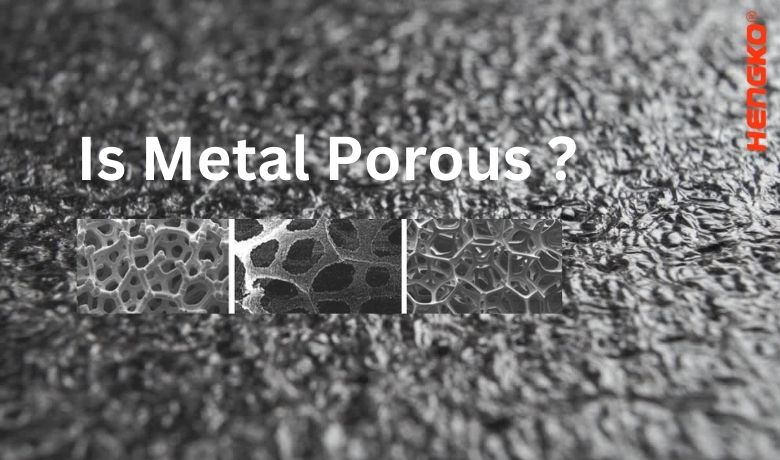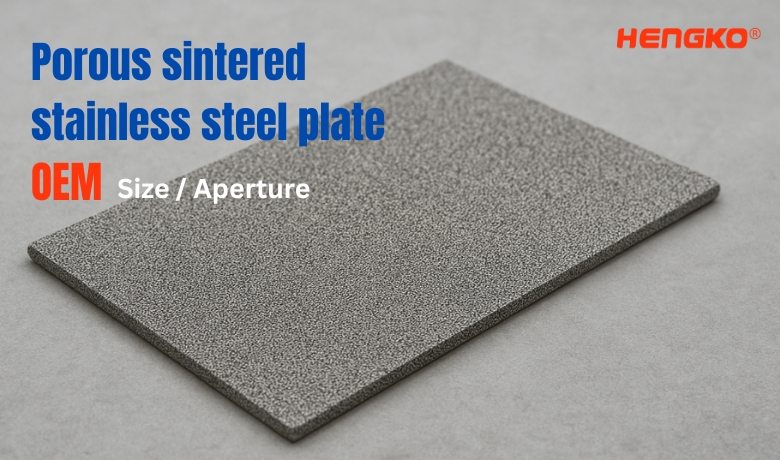Is Metal Porous ? Got Answer Just Read This

Yes — metal can be porous, especially when it is intentionally engineered into structures such as sintered metal,
metal foams, and high-precision porous metal filters.
While most solid metals are naturally dense with very low porosity, modern sintering technology allows manufacturers
to create controlled pore structures that provide excellent filtration, diffusion, wicking, and pressure-resistance performance.
If you want to see how porous metal is actually made and used in industry, check our detailed guide on the kinds
of porous metal filters option.
In this article, we explain what porosity means, why and how metals become porous,
and the key industries that rely on porous metal components.
What is porosity?
Porosity is a measure of the void space (pores) within a material.
It is the ratio of the volume of these void spaces to the total volume of the material.
Porosity affects the physical and mechanical properties of materials such as density, strength and permeability.
There Are Different Types of Porosity, Including:
*Closed Porosity: Voids that are not connected to the surface of a material.
*Open porosity: The voids connected to the surface of a material.
*Through Porosity: The voids connected to both surfaces of a material.
Some examples of porous materials are sponges, paper, and foam, while non-porous materials include glass,
ceramics, and some metals.
What does porous mean?
Porous is an adjective that describes a material that has voids or pores that allow fluids or gases to
pass through it. In other words, it refers to the ability of a material to absorb or allow substances to pass through.
Porous materials have a high surface area and are used in a variety of applications such as filtration,
insulation and absorption. Examples of Porous and Non-Porous Materials
1. Some Examples of Porous Materials Are:
Sponge , Soil, Wood, Foam, Paper, Charcoal
2. Some Examples of Non-porous Materials Are:
Glass , Ceramics, Certain metals (such as gold, silver, and platinum)
Plastic (depending on type)
Porosity in Metals
Metals may be porous due to the manufacturing process or intended use.
Porous metals can have properties such as increased surface area, enhanced thermal and electrical conductivity,
and improved filtration capabilities.
For example,
1.Stainless steel may be porous due to the presence of welds or the formation of corrosion.
2.Aluminum can also be porous due to the formation of oxide layers or impurities in the metal.
3.Steel may be porous due to its manufacturing process or exposure to corrosive environments.
Testing for Porosity in Metals
To determine the porosity of a metal, various methods can be used, such as:
-Metallographic analysis: This involves using a microscope to examine the structure of the metal.
-Radiography: This involves exposing the metal to X-rays to detect internal voids.
-Ultrasonic testing: This involves using high frequency sound waves to detect internal voids.
-Gas pycnometric method: This involves measuring the volume of gas displaced by solid material.
Each method has its advantages and disadvantages and can be chosen according to the requirements of the application.
Porous Metal Applications
Porous metals are used in a variety of applications across industries, including:
-Automotive: Used in fuel injection systems, air filters and exhaust systems.
-Medical: For implants, dental implants and surgical instruments.
-Electronics: For heat sinks and electromagnetic shielding.
-Aerospace: For fuel tanks, heat exchangers and filters.
-Construction: For acoustic panels and facade cladding.
Some of the most popular expanded metal products on the market include expanded metal sheet,
expanded metal tube, expanded aluminum sheet, expanded aluminum sheet, and expanded metal foam.
How to Prevent Pores in Metal
Blowholes can be prevented by taking the following measures:
Proper selection of raw materials and alloys.
Proper preparation of metal surfaces prior to welding or joining.
Appropriate welding or joining techniques and parameters.
Use shielding gas or flux.
Minimize exposure to corrosive environments.
By taking these measures, the formation of voids in the metal can be minimized, resulting in stronger and more reliable metal products.
Is Stainless Steel Porous?
Stainless steel is generally not considered a porous material in the traditional sense because it does not allow substances
to pass through easily.
However, it is important to note that stainless steel surfaces can be modified to make them more or less porous,
depending on the specific finishing process used.
For example, a highly polished stainless steel surface is less porous than a brushed or sandblasted surface.
Also, if the stainless steel surface is damaged or scratched, it may corrode more easily and may
allow substances to penetrate more easily.

Is Aluminum Porous?
Aluminum is generally considered a porous metal because it can readily absorb liquids and gases through its surface.
This is due to the fact that aluminum naturally forms a thin layer of oxide on its surface,
which creates small pores through which substances can pass. However, the degree of porosity
can vary depending on factors such as the alloy of the aluminum, the surface finish,
and any coatings or treatments applied to the surface.
In some cases, aluminum can be reduced in porosity through processes such as anodizing
or coating with a sealant.
Is Steel Porous?
Similar to stainless steel, steel is not generally considered a porous material in the traditional sense.
However, the porosity of steel can depend on many factors, such as the specific type of steel, the surface finish,
and any coatings or treatments applied to the surface.
For example, certain types of steel may have a more open grain structure and are more prone to corrosion
or rust, which can lead to the formation of pores or cavities over time.
Additionally, if the surface of steel is not properly polished or protected, it can become more porous
and susceptible to corrosion or other forms of degradation.
What Are the Popular Porous Metal Products on the Market?
Yes, there are several popular porous metal products on the market.
Some of the most common porous metal products are:
- Perforated Metal Plate
These are flat metals with controlled porosity that can be used for filtration, diffusion and other applications.
They are usually made of stainless steel, titanium or nickel alloys.
- Porous Metal Tube
These are hollow tubes with controlled porosity that can be used for filtration, aeration, and other applications.
They are usually made of stainless steel or titanium.
- Porous Aluminum Plate
These are flat sheets of aluminum with controlled porosity that can be used for filtration, diffusion and other applications.
They are commonly used in industries such as aerospace and automotive.
-Perforated Aluminum Plate
These are flat sheets of aluminum with controlled porosity that can be used for filtration, diffusion and other applications.
They are commonly used in industries such as electronics and medical equipment.
-Porous Metal Foam
These are lightweight three-dimensional structures made of metals with controlled porosity.
They are commonly used in industries such as energy, aerospace and automotive for applications such as heat exchangers,
catalytic converters and sound insulation.
Conclusion
In summary, metals can be porous due to various reasons such as the metal's manufacturing process,
exposure to corrosive environments, or intended use.
Porous metals have multiple applications in different industries and their properties can be
enhanced to meet specific requirements.
Porosity in metals must be tested to ensure their quality and reliability. With proper
measures, porosity in metals can be minimized, resulting in stronger and more durable metal products.